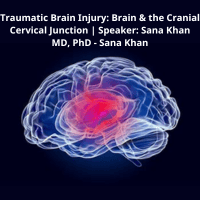Course Summary:
This course, led by Sana Khan MD, PhD, delves into the significant relationship between Traumatic Brain Injury (TBI) and the Cranial Cervical Junction (CCJ). It provides a comprehensive understanding of how trauma to the brain can impact the structures and biomechanics of the upper cervical spine and vice versa. The course explores the neuroanatomical connections between the brain and the CCJ, the potential mechanisms of injury involving both areas, and the clinical implications for diagnosis, treatment, and rehabilitation of individuals with TBI. Dr. Khan’s expertise will guide learners through the complexities of this interconnected system.
Target Audience:
This program is ideal for:
- Medical professionals including physicians (neurologists, physiatrists, primary care), chiropractors, osteopathic physicians.
- Physical therapists and occupational therapists working with TBI patients.
- Athletic trainers and healthcare professionals involved in sports-related head injuries.
- Researchers and students in neuroscience, neurology, and related fields.
- Any healthcare provider seeking a deeper understanding of the interplay between TBI and the cervical spine.
Main Content:
The course likely covers key areas such as:
- Neuroanatomy of the Brain and Cranial Cervical Junction: Detailed review of the relevant anatomical structures and their connections.
- Biomechanics of TBI and CCJ Injuries: Understanding the forces and mechanisms that can lead to injury in both the brain and the upper cervical spine.
- The Interplay Between Brain Injury and Cervical Instability: Exploring how TBI can contribute to or exacerbate instability in the CCJ.
- Clinical Presentation and Diagnosis: Recognizing the signs and symptoms that may indicate involvement of both TBI and CCJ issues.
- Imaging and Diagnostic Techniques: Reviewing relevant imaging modalities and diagnostic approaches for assessing both brain and cervical injuries.
- Potential Neurological Consequences: Understanding how CCJ dysfunction can impact neurological recovery after TBI, including headaches, dizziness, and other symptoms.
- Treatment and Management Considerations: Exploring various approaches to managing patients with both TBI and related CCJ issues.
- Rehabilitation Strategies: Discussing rehabilitation protocols that address the interconnected nature of these injuries.
Explore the critical link between TBI and the cranial cervical junction!
SIGN UP NOW







